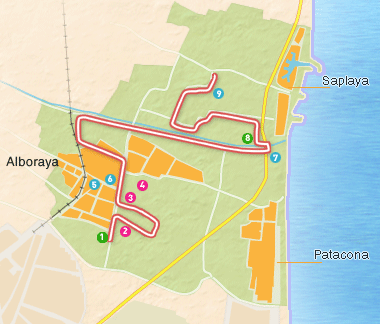
Thanks to its agricultural tradition, specially with the tiger nut, Alboraya maintains a colossal rural architecture, formed by innumerable farmhouses and cottages.
The antique quarter, the fertile region and the rural settlements civil and religious made up the principal stages of this route, that shows the visitors: the temple of Asunción de nuestra Señora, the Puente del Moro, the crops of tiger nuts of the fertile region, the didactic cottage, the chapels of Santa Bárbara or of the Miracle or Peixets and the beach of Patacona and Port Saplaya. Our route starts in the Ethnological Cottage (1) in the area around the cycle lane where the visitor can meet the agricultural utensils of the Huerta. The cycle lane, which crosses its municipal area, allows the visitor to pedal all its corners.
The farmhouses of Les Palmeres (2), de Requeni (3) or del Retoret (4) mark the beginning of our way. This stately buildings are an example of the traditional rural physiognomy. The richness of the cultural patrimony of its city is full of religious temples. The church of the Asunción de Nuestra Señora (5), of medieval origin, is a sample of the Baroque of the XVII century. Walking through its streets we find the bridge of the Moro (6), old pass between Valencia and Alboraya. After visiting the historic quarter, we lead to the ravine of the Carraixet, that crosses the town. Its route will bring us back to the Huerta that vigorously sprouts on the sides of the ravine. We’ll find attractive samples of traditional cottages and cultivations of irrigation, specially the tiger nut until we arrive to the chapel of the Peixets (7), a stunning corner in the estuary of the ravine. The last part of the route will lead us back to the agricultural splendor of the tiger nut. Here, the Didactic Cottage (8) shows the ways of life of the country persons, what were the products and its ways of cultivation. The chapel of Santa Bárbara (9) is another enclave of special interest in which our route ends up.
|

